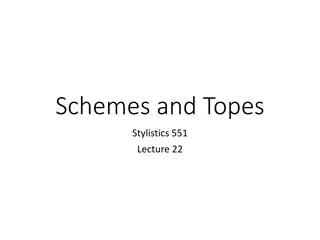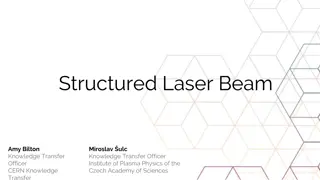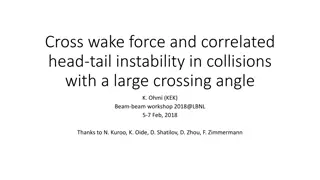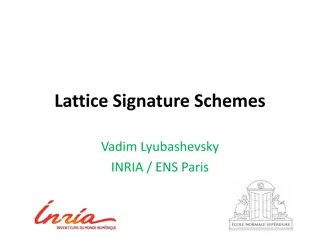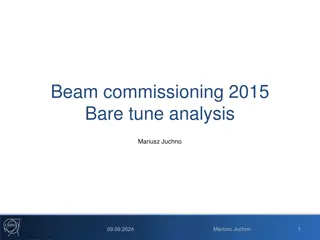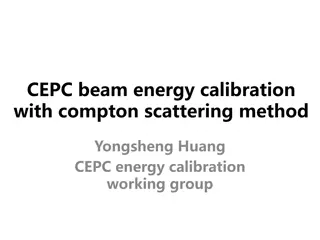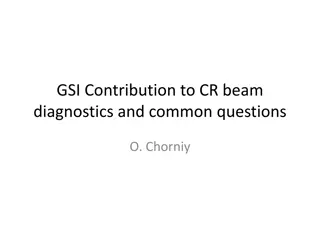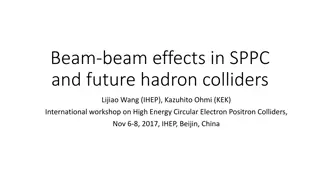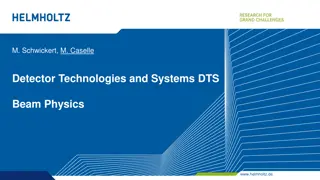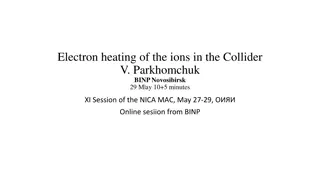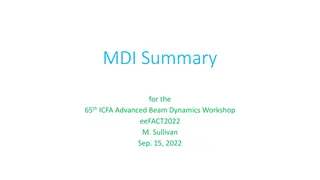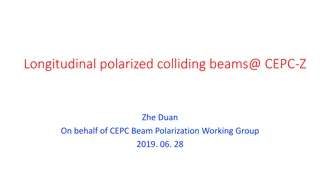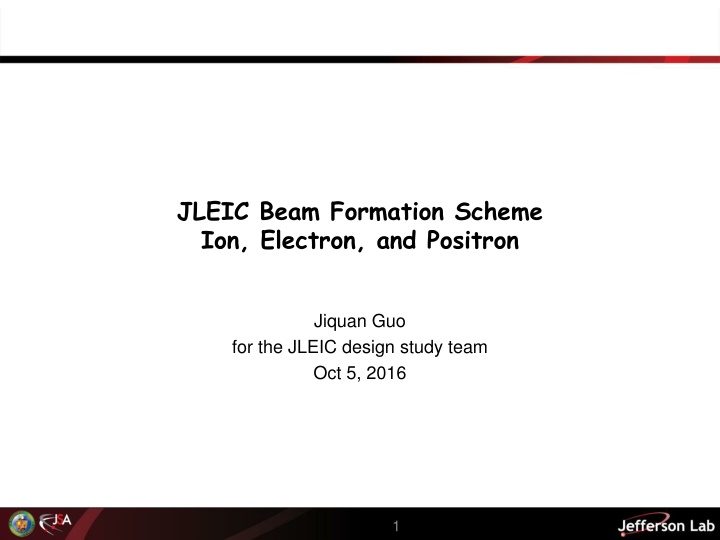
JLEIC Beam Formation Scheme Overview
Explore the beam formation scheme for JLEIC including ion, electron, and positron components. Discover the high luminosity electron-ion collider and the challenges related to beam formation. Learn about Laslett tuneshift, ion complex details, and beam formation cycles for JLEIC design study team.
Download Presentation

Please find below an Image/Link to download the presentation.
The content on the website is provided AS IS for your information and personal use only. It may not be sold, licensed, or shared on other websites without obtaining consent from the author. If you encounter any issues during the download, it is possible that the publisher has removed the file from their server.
You are allowed to download the files provided on this website for personal or commercial use, subject to the condition that they are used lawfully. All files are the property of their respective owners.
The content on the website is provided AS IS for your information and personal use only. It may not be sold, licensed, or shared on other websites without obtaining consent from the author.
E N D
Presentation Transcript
JLEIC Beam Formation Scheme Ion, Electron, and Positron Jiquan Guo for the JLEIC design study team Oct 5, 2016 1
Overview of JLEIC A high luminosity electron-ion collider High bunch reprate and high current Electron complex CEBAF as injector Electron collider ring, 3- 10GeV, up to 3A beam current, 476.3MHz RF system Possible e+ capability Ion complex Ion source Booster Ion collider ring, 40- 100GeV proton energy, 0.5A beam current with possibility to upgrade, 953MHz RF system 2
JLEIC Ion Complex ~8GeV H+ ~2GeV Pb67+ <=100GeV H+ <=40GeV Pb82+ 135MeV H- 40MeV Pb67+ H- Strip Pb Strip collider ring with BB cooler Multi-turn injection Bucket-to- bucket transfer ion SRF Linac sources Booster with DC cooler Major bottleneck and challenges for beam formation: Space charge tune shift, especially at the lowest energy of each ring (right after injection into the booster or collider) Splitting the bunches to 476.3MHz reprate, 952.6MHz in future upgrade RHIC bunch reprate is 9MHz w/o splitting LHC bunch is 40MHz, and each bunch train has only 72 bunches Kicker rise time RHIC ~100ns, LHC ~900ns Cost Two options for linac energy: baseline 285MeV H-/100MeV Pb67+, optional 135/40MeV for phase 1 Baseline booster energy (Ek) is 8.0GeV H-/2.0Gev Pb67+ 2GeV might be slightly short for Pb due to high Laslett tuneshift after injecting into collider ring, considering raising to 2.4-2.8GeV (proton kinetic energy can increase to 9.2-10.4GeV with the same bending magnets) 3
Laslett Tuneshift Coasting beam Rect bunched beam ??????? ????? 4????2??????? Gaussian beam ??????? ????? 4????2?? 2??? ??????? 4????2?? ???= ??? ? ???= ???= = 2??2?? Current Laslett tuneshift calculation is based on coasting/rectangular beam. For Gaussian beam, if we use 2 (containing 95% of particles) as the equivalent rectangular bunch length, tuneshift will be ~1.6 . The design limit for Laslett tuneshift is set at 0.15, although operating at 0.2-0.3 is possible To keep space charge tuneshift within the limit, especially at the injection energy of each stage, we can choose High injection energy at each stage (associate with cost) Larger transverse beam size (limited by physical aperture and magnet cost) Cooling at the injection energy should be minimal or none Long bunch (as a ratio to the bucket size) at injection energy, a practical limit is ~0.7 Limit the total charge in the rings For collider ring, it will put a cap on luminosity For booster ring, lower charge requires more injection cycles to the collider ring At the same energy, for given beam current, smaller ring can lower tuneshift; for given total charge, ring circumference won t change tuneshift. Need to optimize among the above options and constraints 4
Ion Beam Formation Cycles Step 6/7. Bucket-to-bucket transfer to the collider ring and BB cooling, repeat 26 times (Nh=28) 4. Accelerate and cool 2. Accumulating coasting beam DC cooler BB cooler DC cooler 5. Bunch compression to ~56m, split into 2 bunches 3. Capture to bucket 2x80m gaps Collider circumference 2252.8m, final harmonic # Nh=3584(7*2^9), booster circumference 281.6m 1. Eject the used beam from the collider ring, cycle the magnets 2. Multi-turn injection of polarized ion from linac to booster (non-polarized for heavy ions) 3. Capture beam into a bucket (~200m bunch length) 4. Ramp to an intermediate energy (~2.0GeV proton), perform DC cooling, ramp to ~8GeV (proton) 5. Compress the bunch length to 56m 6. Bucket-to-bucket transfer the long bunch into collider ring, each bucket 80m (gap between bunches ~24m, ~80ns) 7. Repeat step 2-6 for 26 times, each cycle ~1 min, total ~25 min 8. Ramp collider ring to collision energy 9. Perform binary bunch splitting up to 7 times to harmonic # Nh=3584 (when colliding high energy/low current electron beam, splitting can be reduced to 5 times to Nh=896), perform bunch length compression and BB cooling 10. Manipulate the beam to create/remove several extra empty buckets (476 MHz) in the gap (Nh=3580-3588 depending on ion energy, as required by beam synchronization). Final bunch train structure in the collider ring Gap of 126-130 empty buckets, ~80m Gap of 126-130 empty buckets 1664 bunches, ~1047m 1664 occupied bunches, ~1047m 5
Alternative Ion Beam Formation Cycles (for 285/100MeV Linac at ~0.4A beam current) Step 5/6. Bucket-to-bucket transfer to the collider ring and BB cooling, repeat 8 times (h=56, each dot refers to two bunches) 4. Accelerate to 7.9GeV and cool 2. Accumulating coasting beam BB cooler DC cooler DC cooler 3. Capture into 7 buckets 2x40-80m gaps Collider circumference 2252.8m, harmonic # Nh=3584(7*2^9), booster circumference 281.6m we need to kick out 2-4 bunches to form the gaps 1. Eject the used beam from the collider ring, cycle the magnets 2. Multi-turn injection of polarized ion from linac to booster (non-polarized for heavy ions) 3. Capture beam into 7 buckets (~28m bunch length for quasi-rectangular beam) 4. Ramp to an intermediate energy (~2.0GeV proton), perform DC cooling, ramp to ~9GeV (proton) 5. Bucket-to-bucket transfer the long bunch into collider ring, each bucket 40m (gap between bunches ~12m, ~40ns) 6. Repeat step 2-6 for 8 times, each cycle ~1 min 7. Ramp collider ring to collision energy 8. Perform binary bunch splitting 6 times to harmonic # Nh=3584, perform bunch length compression and BB cooling 9. If needed, manipulate the beam to create/remove several extra empty buckets (476 MHz) in the gap (Nh=3580-3588 depending on ion energy). Pros: Cons: Less booster cycles, faster injection time Lower beam current in ion collider ring, or higher linac energy 6
SC Tune Shift in the Booster at Different Injection Energy Particle Proton Pb67+ Booster ring circumference (m) 281.6 (1/8 of collider ring) Collider ring circumference (m) 2252.8 (Nh=3580@100GeV) Collider ring beam current (A) 0.5 0.39 1.38 0.5 0.41 1 Collider ring charge ( C) 3.76 2.94 10.38 3.76 3.09 7.52 Linac extraction energy (MeV/u) 135 285 285 40 100 100 Booster cycles 26 8 26 26 8 26 Booster ring charge ( C) 0.145 0.395 0.40 0.118 0.339 0.236 Normalized emittance, step 3 ( m) 1.65 2.63 2.66 0.93 1.51 1.5 Booster SC tune shift, step 3 0.15 0.15 0.15 0.144 0.15 0.11 6 aperture, step 3 (mm, x,y=14m) 38.7 39.8 40.0 39.9 40.1 39.9 Step 3 SC limited at 0.15, beam stay-clear (6 aperture) limited at 40mm. Assuming we can get the desired emittance by controlling the phase painting, DC cooling rate, and maybe scraping 7
Ion Collider Ring SC Tune Shift Particle from the booster H+ Pb67+ Collider ring circumference (m) 2252.8 (Nh=3580@100GeV) Collider ring beam current (A) 0.5 1.38 0.5 0.5 1.0 1.0 Collider ring charge ( C) 3.76 10.4 3.76 3.76 7.52 7.52 Booster extraction energy (GeV/u) 7.9 7.9 2.43 2.04 2.82 2.04 Equiv H extraction energy (GeV) 7.9 7.9 9.15 7.9 10.4 7.9 Booster ring charge ( C) 0.145 0.40 0.118 0.118 0.236 0.236 Normalized emittance, end of step 5/6 ( m) 0.5 1 0.93 1.21 1.50 2.41 Collider ring SC tune shift, end of step 5/6 0.10 0.14 0.15 0.15 0.15 0.15 6 aperture, step 5/6 (mm, x,y=14m) 5.2 7.3 11.7 14.2 13.9 20.0 If emittance at step 5/6 (after the collider ring is filled) can be blown up from step 3 (after the booster ring bunch captured in one RF bucket), 7.9GeV booster should be enough for all particles up to 1A. Otherwise Pb energy needs to be raised to 2.4-2.8GeV (equivalent to 9.2-10.4GeV proton). 8
Alternative Ion Beam Formation Cycles (binary bunch split in the booster ring) Step 6/7. Transfer the bunch train bucket-to-bucket into the collider ring, repeat 24 times, then ramp energy and perform BB cooling 4. Accelerate and cool 2. Accumulating coasting beam DC cooler BB cooler DC cooler 5. compress bunch to ~56m, split into 32 bunches (~80m train) with 5 stages splitting 3. Capture to bucket Collider circumference 2252.8m, harmonic # Nh=3580-3588 (for different collision energy), booster circumference 281.6m 1. Eject the used beam from the collider ring, cycle the magnets 2. Multi-turn injection of polarized ion from linac to booster (non-polarized for heavy ions) 3. Capture beam into a bucket (~200m bunch length) 4. Ramp to an intermediate energy (~2.0GeV proton), perform DC cooling, ramp to ~8GeV (proton) 5. Compress the bunch length to 56m, perform 5 stages binary split and form a 80m train with 32 bunches (bunch reprate 119MHz) 6. Bucket-to-bucket transfer the 80m bunch train into the collider ring 7. Repeat step 2-6 cycle for 24 times, leaving a gap of ~14m (5-6 119MHz buckets, ~45ns for kicker rise time) between the 80m trains 8. Ramp collider ring to collision energy 9. Perform up to 2 stages binary splitting (no splitting needed for low reptate option with high energy/low current electron beam), perform bunch length compression and BB cooling 10. Manipulate the beam to create/remove several extra empty buckets (476 MHz) in the gap (Nh=3580-3588 depending on ion energy, as required by beam synchronization). Pros: Less splitting cavities in the collider ring Potential problems: Need to split beam 5 times in each of the 24 cycles Total gap length is larger, especially if inject kicker rise time is longer than 45ns; may still need longer gap for abort kicker 9
Alternative Ion Beam Formation Cycles (less bunch splitting stages) Step 6. Transfer the bunch train bucket-to-bucket into the collider ring, repeat 8 times, then ramp energy and perform BB cooling 2. Accumulating coasting beam 4. Accelerate and cool BB cooler DC cooler 3. Capture to 119MHz bucket Collider circumference 2252.8m, harmonic # Nh=3580-3588 (for different collision energy), booster circumference 281.6m 1. Eject the used beam from the collider ring, cycle the magnets 2. Multi-turn injection of polarized ion from linac to booster (non-polarized for heavy ions) 3. Capture beam into 112 buckets (119MHz bucket, ~1.8m bunch length), kick out 5-6 bunches to form a gap for extraction kicker rise time 4. Ramp to an intermediate energy (~2.0GeV proton), perform DC cooling, ramp to ~8GeV (proton) 5. Bucket-to-bucket transfer the ~270m bunch train into the collider ring 6. Repeat step 2-6 cycle for 8 times 7. Ramp collider ring to collision energy 8. Perform up to 2 stages binary splitting (no splitting needed for low reptate option with high energy/low current electron beam), perform bunch length compression and BB cooling 9. Manipulate the beam to create/remove several extra empty buckets (476 MHz) in the gap (Nh=3580-3588 depending on ion energy, as required by beam synchronization). Pros: Potential problems: Much less splitting stages. Lower ion collider ring beam current or higher ion linac energy. 10
Summary for Ion beam formation scheme The current preferred scheme is to inject compressed long bunches from the booster into the collider ring, and perform multiple (up to 7) binary splits in the collider ring. Compress the bunch length in the booster (at the booster s top energy) allows more booster cycles, resulting higher ion collider ring beam current and/or lower linac energy, with a safe space charge tuneshift. The total injection time is longer, but still in ~0.5hr range The gap between long bunches is preferred to be ~80ns for a conservative injection kicker rise time, but 40ns or shorter is possible to achieve. To split bunched beam, binary splitting needs the most number of stages, but is easier to get even splitting with low beam loss. It also requires the least number of RF frequencies. Moving (most of) the bunch splitting to the booster ring is possible, but results in extra gaps in the collider ring. The splitting needs to be repeated for each booster cycle, which may result in a longer beam formation time. An alternative to binary splitting bunched beam is to form a rectangular beam with barrier bucket, and split to 119MHz or 476MHz with single frequency. 11
Electron Ring Injection (electron and positron) Electron: no much change since last year Using CEBAF to accelerate electron pulses of ~1050m bunch trains, yielding ~5.5MW pulsed extracted beam power. Bunch reprate 68MHz in CEBAF to match the electron ring/PEP-II RF frequency, up to 35pC per bunch Each bunch train fills 1/7 of the buckets in half of the electron ring alternately with alternating polarization; ~1 electron ring damping time between two injecting bunch trains Injection time range from a few minutes to 20 minutes, depending on energy and beam current in the collider ring. Using feedforward to match CEBAF klystron power with beam pattern and minimize linac gradient drooping Positron: Polarized positron source using ~10MeV electron beam shower ~10-4 yield including collecting efficiency Simply increasing charge per bunch in the electron gun can not produce positron at anything close to 35pC/bunch, but average positron beam current is sufficient for JLEIC injection with current electron gun capability Need to adapt the source s low peak current/high duty factor characteristics for JLEIC injection Multi-turn injection into an accumulator ring from electron gun with phase painting Multi-turn injection into JLEIC within one damping cycle using phase painting (may also apply to electron injection) 12
CEBAF as JLEIC Positron Injector 500-Turn Positron Polarized Electron 10 MeV Injector Accumulator Ring (23.8m) Conversion/Collection Efficiency ~ 10-4 Bunch Management Harmonic kicker Extraction to CEBAF/JLEIC 10 MeV pol e- 0.67 nC bunches @ 1500 MHz 10 MeV polarized e- 0.67 nC @ 68.1 MHz (22 stretching) 10 MeV polarized e- 1.33 pC @ 1500 MHz 5-7 MeV Polarized e+ 67 fC @ 68.1 MHz Polarized Electron Source Accumulator Ring Electrons at Converter Polarized Positron Source R&D Challenge 1.33 pC @ 1497 MHz 2 mA peak Up to 0.12mA avg ~40 s mini train 1497 MHz 1 A peak 119 bunches 68.1 MHz 45mA peak up to 0.12mA avg 1.75 s, 525m train 68.1 MHz 4.5 A peak up to 12nA avg 1.75 s, 525m train Electron accumulator Harmonic extraction Target: 450 kW peak One macro bunch train contains about 30 mini trains; Mini train is 40 s from the source, ~80ns in the accumulator, and stretched to 1.75 s in CEBAF. Each of the 30 mini trains will be injected into the same 119 buckets in a quarter of the JLEIC collider ring at the interval of ~6 collider ring revs (~45 s) with phase painting. Interval between macro bunch trains will be around 2x transverse damping time, ranging from 20-700ms depending on energy and use of damping wigglers. Using 20ms interval and 10GeV 0.71A colliding beam, the injection time can be <10 min. For lower collision beam energy, it may take longer due to damping time, but we may have options to increase injection rate, like increasing the painting cycles in one damping cycle, and using damping wigglers 13
Multi-turn Injection: Phase Painting Concept: an orbit bump created near a septum and then slowly reduced as beam being injected (phase-space painting) x > Septum thickness + bunch width Accumulator ring x Injected beam A number of painting schemes have been developed Process can also be simultaneously occurring in vertical and longitudinal dimensions CERN s LEIR has a design for 75-turn injection of Pb54+, We plan to push this number to a few hundred to ~1000 in the accumulator using low electron emittance, and ~30 in collider ring Main injection system components Magnetic or electrostatic septum Four bumper magnets with ~1 s rise time for 10MeV, reasonably fast fall-off time and ~10 mrad maximum deflection For 3-10GeV electron beam, rise time ~1.4ms (180 turns), ~1mrad 14
Harmonic Kicker Extraction Example: A ring using a harmonic kicker to extract bunch train 3 longer Example: Waveform that kicks 1 in every 10 bunches bunch reprate 476MHz Synthesized with 9 RF harmonics and 1 DC mode Synthesized waveform (kV) Empty ring buckets already kicked out to linac 60 Ring buckets still occupied by bunches 50 Empty linac buckets 40 30 Linac buckets occupied by extracted bunches 20 10 Harmonic kicker that kicks every 3rd bunch 0 0 1 2 3 4 5 6 Z0 (m) Ideal kicker pulse Generate 68MHz (or 34/17MHz) bunch train for JLEIC injection from a compact 1497MHz accumulator (i.e., 24m circumference). The extracted bunch train will be stretched, and it will be ideal if it matches the bunch train length in the collider ring or its fraction (1050m or 525/350m) Harmonic kicker kicks out 1 in every 22 bunches to generate 68MHz beam from 1497MHz beam. In synergy with the harmonic kicker R&D for the circulating e-cooler ring, which kicks 1 in every 10 or 25 bunches (Y. Huang s talk in this meeting). Accumulator ring harmonic number needs to be reciprocal with 22 (or other bunch stretching ratio to be used). Kicker rise time should be few ns (unless Nh=stretching ratio 1, where a gap in the ring won t break the continuity of the stretched bunch train), possible with stripline kicker (and the stripline s power requirement for 10MeV beam is not bad). If the harmonic kicker rise time is a problem (comparable to the accumulator ring revolution time), we need a second ring, in which a harmonic extraction kicker keeps firing all the time. 15
Harmonic Stripline Kicker Port4, to matched load Z0, 50-100 Port2 +V d -V Port3, to matched load Port1 PEP-II feedback kicker design as an example Travelling wave TEM mode RF kicker Need to adjust the length of the kicker to optimize the efficiency for desired waveform, ~0.7 wavelength of the highest mode Kicker rise time should be twice the electrical length of the kicker (~1ns in our case) plus the rise time of the RF sources (including sync error of different modes). Less than 1kW needed to get ~1mrad for 10MeV beam and kicking ratio of 22 16
Alternative Parameters for Positron Formation Stretching bunch train with gap in the accumulator ring 500-Turn Positron Polarized Electron 10 MeV Injector Accumulator Ring (18m) Conversion/Collection Efficiency ~ 10-4 Bunch Management Harmonic kicker Extraction to CEBAF/JLEIC 10 MeV pol e- 2 nC bunches @ 748.5 MHz 10 MeV polarized e- 2 nC @ 17 MHz (44 stretching) 10 MeV polarized e- 4 pC @ 748.5 MHz 5-7 MeV Polarized e+ 0.2 pC @ 17 MHz Polarized Electron Source Accumulator Ring Electrons at Converter Polarized Positron Source R&D Challenge 4 pC @ 748.5MHz 3 mA peak Up to 0.09mA avg ~40ns 500 30 train 748.5 MHz 1.5 A peak 30/45 bunches 20ns gap 17MHz 34mA peak up to 0.09mA avg 1.75 s, 525m train 17 MHz 3.4 A peak up to 9nA avg 1.75 s, 525m train Electron accumulator Harmonic extraction Target: 340 kW peak 20ns gap allows more reasonable kicker rise time 17MHz allows reducing collider ring bunch reprate by factor of 4, may help increase luminosity for low beam current/high energy collision cases, when beam-beam is not a bottleneck. Factor of 44 stretching might be more challenging for harmonic kicker design 17
Summary for Electron and Positron Injection Positron: A small accumulator ring can increase the charge per bunch from the source, multi- turn phase painting is the key Need multi-turn injection into the collider ring within a damping cycle, Also needs phase painting. Need a harmonic kicker to convert 1497MHz beam into 68MHz (or 34/17MHz) beam Electron injection scheme has not changed much since last year, but we might adapt the phase painting technic, if further study shows that it s feasible. It could either provide faster injection rate when damping time is really long, or help alleviating the charge per bunch requirement for the gun and the gradient droop in CEBAF. 18
Acknowledgements This work is done by the whole MEIC accelerator design study team, particularly Alex Bogacz, Joe Grames, Fanglei Lin, Vasiliy Morozov, Robert Rimmer, Todd Satogata, Haipeng Wang, Shaoheng Wang, Yuhong Zhang 19
Adding Extra Bucket to Change Nh Synchronizing low ion beam with electron beam may need to change harmonic number in the collider ring by increment of 1, by a total of up to 10. Binary bunch splitting scheme for certain Nh will not work for Nh+1 We may split the bunch to Nh, and add extra buckets in the gap by ramping the RF frequency and jump phase in the gap. Gap2, 1/28 circumference, 268ns two bunch trains plus Gap1 Total 27/28 circumference RF phase shift in gap2 Cav freq (on resonance) Harmonic number kept at Nh during ramp 0 After splitting to Nh f0 2 27 ? ?0+ ? Ramping frequency ?0 Up to phase shift within 268ns for a low voltage cavity Cavity Ql needs to be ~100 ?0+ ?0/(2Nh) 2 27 ? Ramping frequency ?0+ ?0/Nh ? ?0 Harmonic number change to Nh+1 ?0+ ?0/Nh Ramping complete 0 21



